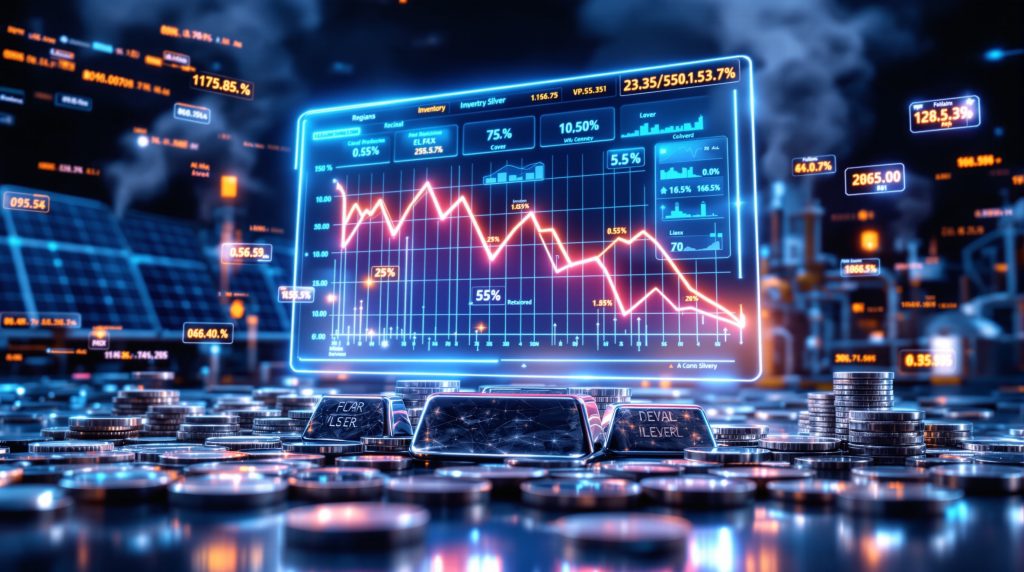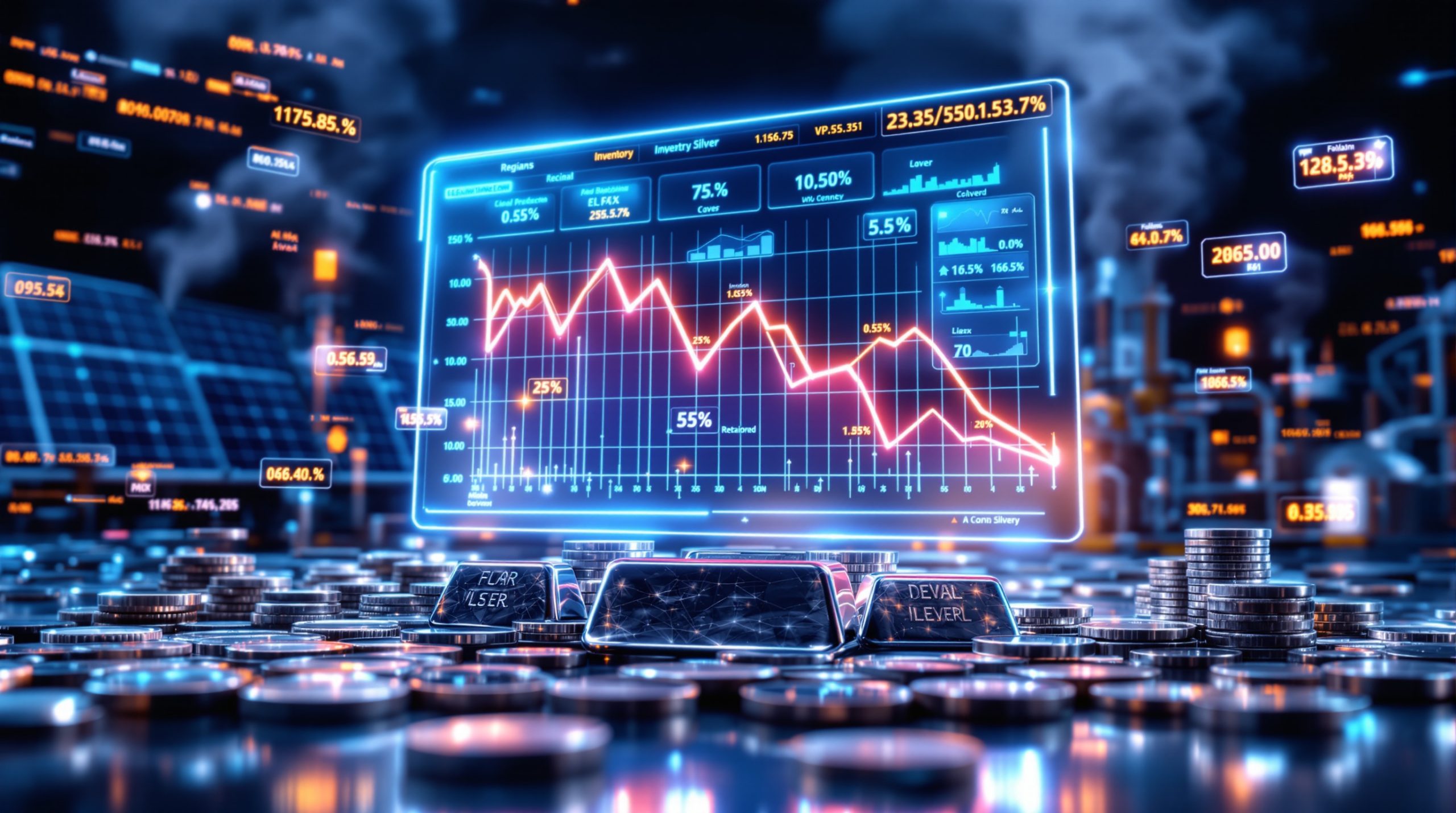The Evolution of Modern Silver Markets: Understanding Supply Dynamics in an Era of Industrial Transformation
The global silver supply crunch has emerged as a defining characteristic of contemporary precious metals markets, fundamentally reshaping investor expectations and industrial procurement strategies. The convergence of technological advancement, monetary policy shifts, and evolving industrial applications creates a complex landscape that challenges conventional market analysis frameworks. Understanding these dynamics requires examining both structural supply limitations and demand acceleration patterns that distinguish current silver markets from historical precedents.
The precious metals sector has witnessed significant volatility throughout 2024, with silver experiencing particular attention from both institutional and retail investors. Market observers note distinct regional variations in availability, pricing premiums, and delivery timelines that suggest underlying supply chain tensions. These developments occur against a backdrop of expanding industrial applications, particularly in green technology sectors, creating new demand vectors that may fundamentally alter long-term market equilibrium.
What Defines Supply Stress in Contemporary Silver Markets?
Market analysts differentiate between temporary supply disruptions and structural imbalances when evaluating silver market conditions. Recent observations indicate periodic regional shortages, particularly in European markets, where logistics and distribution bottlenecks have created temporary price premiums and extended delivery periods. These localised constraints often resolve through international arbitrage, with surplus inventory from other regions redistributing to meet demand concentrations.
The silver market squeeze has become increasingly evident across multiple market tiers, with varying degrees of impact on different participant categories. Furthermore, this phenomenon has created distinct pricing structures that deviate from traditional precious metals trading patterns.
Regional Supply Redistribution Patterns:
• European market tightness during Q3-Q4 2024 periods
• US inventory surplus facilitating international shipments
• Asian market stability with consistent supply availability
• Premium variations ranging 8-15% above spot pricing in retail channels
The distinction between physical silver markets and paper derivative instruments becomes particularly relevant during supply stress periods. Exchange-traded silver contracts may maintain liquidity whilst physical delivery channels experience constraints. This divergence creates tracking errors between spot prices and actual transaction costs in physical markets, particularly affecting retail investors and smaller institutional buyers.
Exchange Inventory Analysis:
According to CME Group data, COMEX registered silver warehouse stocks maintained levels above 200 million ounces throughout 2024, indicating adequate supplies for futures contract delivery. However, this aggregate figure masks regional distribution challenges and does not reflect retail market availability, where premiums expanded significantly during peak demand periods.
Understanding Market Structure Fundamentals
The silver market operates through multiple interconnected channels, each with distinct characteristics affecting supply availability. Primary market participants include industrial end-users requiring specific purity standards, investment-grade physical buyers, and speculative traders focusing on price movements rather than physical delivery.
Industrial demand typically involves long-term supply contracts with established refiners and distributors, insulating these buyers from short-term market fluctuations. Investment demand, particularly retail physical purchases, bears the primary impact of supply constraints through premium expansion and delivery delays. This structural separation means industrial silver consumption continues relatively unaffected during retail supply stress periods.
Market Tier Analysis:
• Industrial Contract Market: Stable pricing, long-term agreements, minimal disruption
• Institutional Physical Market: Moderate premiums, professional storage, good availability
• Retail Physical Market: High premiums, limited selection, extended delivery times
• Derivative/Paper Market: Liquid trading, minimal physical constraints, price discovery role
Industrial Demand Transformation Driving Market Evolution
Solar photovoltaic manufacturing represents the largest single industrial application for silver, consuming approximately 8,000-9,000 tonnes annually according to International Energy Agency assessments. This translates to roughly 289 million ounces, making solar PV the dominant industrial demand driver. However, manufacturing efficiency improvements continue reducing silver content per watt of solar capacity, creating a dynamic where absolute tonnage remains high despite per-unit consumption declining.
Solar Industry Silver Intensity Trends:
| Year | Grams Silver/Watt | Global PV Installations (GW) | Total Silver Consumption (Tonnes) |
|---|---|---|---|
| 2010 | 10-12 | 17 | 2,040-2,448 |
| 2015 | 7-9 | 50 | 4,200-5,400 |
| 2020 | 5-7 | 139 | 8,340-11,676 |
| 2024 | 3-5 | 180+ | 6,480-10,800 |
Sources: International Technology Roadmap for Photovoltaic (ITRPV) 2023; IEA Global Energy Review
Electric vehicle production introduces additional silver demand through electrical contacts, conductive adhesives, and component applications. With global EV production reaching 13.6 million units in 2023 and each vehicle requiring approximately 20-50 grams of silver, this sector contributes an estimated 272-680 tonnes of annual demand. In addition, this silver supply deficits scenario represents only 2-3% of total industrial usage, making it a growing but relatively minor demand component.
Traditional Industrial Applications Resilience
Electronics manufacturing maintains steady silver consumption despite technological substitution efforts. Electrical contacts, switches, and circuit board applications continue requiring silver's unique conductivity and corrosion resistance properties. The USGS reports approximately 4,000-5,000 tonnes annually consumed across electronics and electrical applications, though this sector experiences gradual decline through miniaturisation and alternative material adoption.
Medical and healthcare applications represent a specialised but growing market segment. Silver's antimicrobial properties drive usage in wound dressings, medical device coatings, and hospital equipment surfaces. Industry estimates suggest 500-800 tonnes annual consumption in healthcare applications, with growth potential tied to aging demographics and infection control awareness.
Industrial Demand Summary:
• Solar PV Manufacturing: 8,000-9,000 tonnes annually (largest single application)
• Electronics/Electrical: 4,000-5,000 tonnes annually (declining trend)
• Electric Vehicles: 272-680 tonnes annually (rapid growth from small base)
• Medical/Healthcare: 500-800 tonnes annually (steady growth)
• Other Industrial: 2,000-3,000 tonnes annually (photography, chemicals, catalysts)
Mine Production Constraints and Byproduct Dependencies
Global silver mine production maintained relatively stable output around 24,000-25,500 tonnes annually from 2018-2023, according to USGS data. This production plateau occurs despite rising prices and industrial demand growth, reflecting structural constraints in silver extraction economics. The fundamental challenge stems from silver's predominant status as a mining byproduct rather than a primary extraction target.
Approximately 70% of silver production derives from copper, lead, and zinc mining operations where silver represents a secondary revenue stream. This dependency means silver production decisions are driven by primary metal economics rather than silver price signals. Consequently, rising silver prices have limited ability to incentivise increased production, creating supply inelasticity that differs from primary commodity markets.
Top Silver Producing Countries (2023):
| Country | Production (Tonnes) | Global Share | Primary Source |
|---|---|---|---|
| Mexico | 5,900 | 24% | Mixed primary/byproduct |
| China | 3,600 | 15% | Primarily byproduct |
| Peru | 3,400 | 14% | Primarily byproduct |
| Australia | 1,600 | 6-7% | Primarily byproduct |
| Russia | 1,500 | 6% | Mixed sources |
Source: USGS Mineral Commodity Summaries 2024
How Do Ore Grade Declines Impact Silver Production?
Silver ore grades have experienced long-term decline from approximately 0.12% in 2000 to 0.08-0.09% in recent years. This degradation reflects broader mining industry trends affecting most metals as easily accessible, high-grade deposits become exhausted. Lower ore grades require increased processing volumes and energy consumption to maintain equivalent silver output, raising production costs and environmental impacts.
Mine development timelines for major base metal projects typically require 7-10 years from discovery to production. Since silver primarily derives from these operations, silver supply expansion follows copper, lead, and zinc project development cycles rather than independent silver market signals. This structural lag means current silver prices have limited near-term supply response capability.
Development Pipeline Challenges:
• Environmental Permitting: Extended approval timelines in major producing regions
• Capital Requirements: Large upfront investments favour established mining companies
• Infrastructure Needs: Remote locations require substantial transportation and utility development
• Water Availability: Mining operations compete with agricultural and municipal water demands
Regional Supply Chain Analysis and Geographic Constraints
Mexico's position as the world's largest silver producer reflects both geological advantages and established mining infrastructure. However, Mexican production has plateaued around 5,500-6,500 tonnes annually despite significant reserves, indicating constraint factors beyond resource availability. Environmental regulations, infrastructure limitations, and declining ore grades at mature operations contribute to this production ceiling.
Mexican Silver Mining Constraints:
• Regulatory Environment: Stricter environmental standards affecting new project approvals
• Infrastructure Age: Many operations date to colonial period requiring modernisation
• Water Scarcity: Competition between mining and agricultural water usage in key regions
• Security Concerns: Some mining regions affected by organised crime activities
Peru represents the third-largest silver producer globally but faces distinct infrastructure challenges limiting expansion potential. Remote mine locations require significant transportation infrastructure investment, whilst environmental regulations in highland regions create permitting complexities. Political instability and community relations issues add additional operational risks for mining companies.
Processing and Refining Capacity Limitations
Silver refining capacity represents a potential bottleneck between mine production and end-user delivery. Industrial applications require specific purity standards (typically 99.9% or higher), necessitating specialised refining facilities. Geographic concentration of refining capacity in specific regions can create logistical constraints during high demand periods.
Global Refining Capacity Distribution:
• North America: 8,000-9,000 tonnes annual capacity
• Europe: 6,000-7,000 tonnes annual capacity
• Asia-Pacific: 12,000-15,000 tonnes annual capacity
• Latin America: 4,000-5,000 tonnes annual capacity
Quality specifications for industrial applications create additional complexity, as different end-uses require varying purity levels and physical forms. Solar PV manufacturing needs silver paste with specific particle sizes and chemical properties, whilst electronics applications require different specifications. This segmentation can create localised supply constraints even when aggregate capacity appears adequate.
Investment Demand Dynamics and Market Psychology
Physical silver investment demand exhibits distinct cyclical patterns influenced by economic uncertainty, monetary policy changes, and precious metals sentiment cycles. Exchange-traded fund (ETF) flows provide measurable indicators of institutional investment demand, whilst retail coin and bar sales reflect individual investor behaviour patterns.
Recent market commentary from precious metals analysts suggests investor psychology plays a dominant role in silver price movements during speculative periods. Market participants often respond to perceived shortages or supply constraints regardless of fundamental supply-demand balance, creating self-reinforcing price momentum cycles. Furthermore, the development of silver squeeze strategies has become increasingly sophisticated among institutional investors.
Investment Demand Categories:
• ETF Holdings: Professional management, large volume transactions, price-sensitive
• Retail Physical: Individual investors, premium-insensitive during sentiment extremes
• Institutional Direct: Pension funds, hedge funds, strategic allocation decisions
• Central Bank Reserves: Limited but growing as monetary policy tool
Speculative Market Dynamics
Silver markets experience periodic speculative episodes characterised by rapid price appreciation, premium expansion, and supply perception shifts. These episodes often coincide with broader precious metals sentiment cycles, geopolitical tensions, or monetary policy uncertainty periods.
Market observers note the gold-silver ratio as a key technical indicator during speculative phases. However, comprehensive gold-silver analysis suggests extreme ratio levels (below 30:1 or above 100:1) often coincide with sentiment turning points. Current ratio levels around 78-80:1 indicate silver's relative underperformance compared to gold, potentially creating conditions for catch-up moves if precious metals sentiment remains positive.
Speculative Cycle Characteristics:
• Initial Phase: Institutional accumulation, moderate price increases
• Momentum Phase: Retail investor participation, premium expansion
• Speculative Phase: Media attention, supply perception changes
• Exhaustion Phase: New buyer scarcity, fundamental rebalancing
Price Discovery and Valuation Framework Analysis
Silver price discovery occurs through multiple interconnected markets including spot trading, futures contracts, and physical transactions. The London Bullion Market Association (LBMA) provides benchmark pricing through twice-daily fixing processes, whilst COMEX futures contracts offer price discovery for North American markets.
During supply stress periods, price discovery mechanisms may experience distortions as physical and paper markets diverge. Futures contracts maintain liquidity through financial settlement, whilst physical markets experience availability constraints and premium expansion. This separation can create arbitrage opportunities but also pricing inefficiencies affecting market participants differently.
Valuation Model Components:
• Production Cost Floor: Mining cash costs plus capital allocation requirements
• Industrial Demand Elasticity: Price sensitivity analysis for major applications
• Investment Demand Sensitivity: Correlation with economic uncertainty indicators
• Supply Response Timeline: Lead times for production capacity adjustments
Technical Analysis During Market Stress
Traditional technical analysis indicators require adaptation during supply-constrained periods as volume patterns and price relationships may deviate from historical norms. Momentum indicators can provide misleading signals when physical availability constraints limit normal arbitrage mechanisms.
Support and resistance levels established during normal market conditions may prove inadequate during supply stress episodes. Premium expansion in physical markets can create price floors above traditional technical support levels, whilst limited availability can extend price movements beyond conventional resistance points.
Technical Indicator Adaptations:
• Volume Analysis: Distinguish between paper and physical market volumes
• Premium Tracking: Monitor spot-to-physical price relationships
• Inventory Levels: Incorporate exchange warehouse data
• Lease Rate Monitoring: Track short-term borrowing costs as shortage indicators
Risk Management Strategies for Market Participants
Industrial users facing silver supply uncertainties often implement inventory building strategies to ensure production continuity. However, carrying costs and working capital requirements limit practical inventory levels, creating ongoing supply security concerns for manufacturers with significant silver requirements.
Forward contracting provides price certainty but requires counterparty risk assessment and may limit benefit from favourable price movements. Options strategies can provide downside protection whilst maintaining upside participation, but premium costs can be substantial during volatile periods. In addition, potential tariff impacts on silver must be considered in international supply chain planning.
Hedging Strategy Framework:
• Physical Inventory: Direct ownership, storage costs, insurance requirements
• Forward Contracts: Price certainty, counterparty risk, limited flexibility
• Options Strategies: Asymmetric risk profile, premium costs, complexity
• Derivative Combinations: Customised risk management, execution complexity
Portfolio Allocation Considerations
Investment portfolio allocation to silver requires consideration of volatility characteristics, correlation patterns with other assets, and liquidity requirements. Silver typically exhibits higher volatility than gold whilst maintaining positive correlation with broader precious metals trends.
Physical silver holdings provide portfolio diversification benefits but require storage solutions and insurance arrangements. ETF exposure offers liquidity advantages but may not provide identical performance during supply-constrained periods when physical premiums expand significantly.
Allocation Framework Elements:
• Risk Tolerance Assessment: Volatility comfort levels, portfolio size considerations
• Liquidity Requirements: Timeline for potential liquidation needs
• Storage Solutions: Home storage, professional vaults, insurance coverage
• Tax Implications: Capital gains treatment, reporting requirements
Long-term Market Structure Evolution
Silver market structure continues evolving through technological advancement, regulatory changes, and shifting industrial demand patterns. Solar photovoltaic efficiency improvements exemplify how technological progress can simultaneously increase absolute silver demand whilst reducing per-unit intensity requirements.
Recycling capacity expansion represents a potential supply augmentation source as accumulated silver in electronic devices, solar installations, and other applications reaches end-of-life status. However, recycling economics require sufficient price incentives to justify collection and processing costs, creating price-dependent supply elasticity.
Structural Change Drivers:
• Technology Development: Efficiency improvements, substitute materials research
• Recycling Infrastructure: Collection systems, processing capacity expansion
• Regulatory Evolution: Environmental standards, mining permit requirements
• Market Mechanism Innovation: Trading platform development, delivery systems
Future Supply-Demand Balance Scenarios
Multiple scenarios exist for future silver market balance depending on industrial demand evolution, mine production development, and recycling capacity growth. Conservative scenarios assume modest industrial demand growth offset by efficiency improvements and limited mine production expansion.
Aggressive scenarios incorporate accelerated green technology adoption driving industrial demand beyond current projections, whilst supply response remains constrained by byproduct dependencies and development timelines. Under these conditions, structural imbalances could persist or intensify, potentially leading to a prolonged silver supply crunch.
Scenario Planning Variables:
• Solar Installation Rates: Global renewable energy adoption timelines
• Mining Project Development: Success rates, permitting timelines, capital availability
• Technology Substitution: Alternative material development, efficiency improvements
• Economic Growth Patterns: Industrial production levels, investment demand cycles
The silver market's complexity reflects its dual nature as both industrial commodity and investment asset. Supply constraints may develop through multiple pathways including production limitations, logistical bottlenecks, or demand acceleration. Understanding these dynamics requires comprehensive analysis spanning geological factors, technological trends, and market psychology patterns.
Market participants must balance fundamental analysis with recognition of speculative and sentiment-driven factors that can dominate short-term price movements. While supply-demand fundamentals provide important context, investor psychology and market structure evolution continue shaping silver market behaviour in ways that challenge traditional commodity analysis frameworks. Consequently, the ongoing silver supply crunch represents both challenge and opportunity for market participants across all sectors.
Disclaimer: This analysis is for educational purposes only and should not be considered as investment advice. Precious metals markets involve substantial risk of loss. Past performance does not guarantee future results. Readers should consult qualified financial advisors before making investment decisions.
Ready to Capitalise on Silver Market Opportunities?
Discovery Alert's proprietary Discovery IQ model delivers real-time alerts on significant ASX mineral discoveries, including precious metals opportunities that could benefit from current silver market dynamics. With silver supply constraints creating unique market conditions, subscribers gain instant access to actionable insights on discovery opportunities that have historically generated substantial returns, positioning themselves ahead of broader market recognition.




